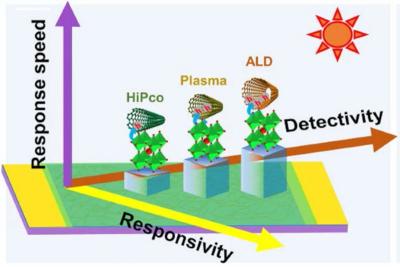Researchers from China's Hebei University of Technology and Chinese Academy of Sciences have found that increasing the diameter of single-wall carbon nanotubes (SWCNTs) in SWCNT/perovskite QD heterojunctions can improve the optoelectronic performance of the heterojunction between the two materials.
The team systematically tested the performance effects of varying diameters of SWCNTs, a single layer of carbon atoms that form a hexagonal lattice rolled into a seamless cylinder, with different band gaps, or the amount of energy required for an electron to conduct electric current, in heterojunction films with perovskite QDs. Their study indicated that increasing the diameter of SWCNTs improved the responsivity, detectivity and response time of this type of heterojunction film. This effect may be mediated by the enhanced separation and transport of photogenerated excitons, an energy-carrying, neutrally charged electron that combines with a positive electron hole, in the film.
"The alignment between the band gaps of SWCNTs and QDs determines the separation of the photogenerated excitons at the heterogeneous interfaces, while different diameter SWCNTs show different carrier capacity and mobility," said Huaping Liu, the principal investigator of the study and professor at the Institute of Physics at the Chinese Academy of Sciences in Beijing, China.
"These characteristics determine the photoelectronic performance of SWCNTs/perovskite QDs heterojunction films, making it… important to systematically study the diameter effect of different band gap SWCNTs on the photodetection performance of these films."
The team investigated the differences in photodetector performance for SWCNT diameters between 1.0 and 1.4 nm. Characteristics of each diameter were assessed by exposing the SWCNT/perovskite QD films to 410 nm light at differing intensities and measuring the current-voltage curves of each film. This data could then be used to determine the photocurrent, photoresponsivity and detectivity at each nanotube diameter.
The band gap of SWCNTs is roughly inversely proportional to the diameter of the nanotube. When SWCNT diameter was increased from 1.0 nm to 1.4 nm, the research team observed an increase in responsivity by about one order of magnitude, a 5-fold increase in detectivity and a 4-fold increase in response speed. The larger-diameter SWCNTs measured in the study improved carrier capacity and mobility to enhance film performance.
"The great improvement in the photoelectric performances in films with larger-diameter SWCNTs is attributed to increasing built-in electric fields at the heterojunction interface of s-SWCNTs semiconducting SWCNTs/QDs…, which drives the separation of hole carriers from photogenerated excitons to s-SWCNTs and rapid transport in SWCNT films," said Liu.
Next-generation photodetectors made from SWCNTs and QDs can help reduce the material cost, energy consumption and fragility of these types of detectors in future electronics. Interestingly, SWCNT monolayer films alone are very inefficient at detecting light, and perovskite QD films are prone to low carrier mobility, responsivity and detectivity. In contrast, perovskite quantum dot films, when paired with SWCNT monolayers, improve optical absorption as a thin, bilayer film with enhanced responsivity.
The results of this study can help other scientists in the design and fabrication of new high-performance photodetectors required for optical communications, wearable technologies and other applications in medicine and artificial intelligence. The team plans to utilize these experimental findings specifically in the design of optimized photodetectors for use in highly sensitive artificial vision systems.




